integration testing 7
高效软件研发的实用方法

高效软件研发的实用方法软件研发是一个复杂而又需要高效率的过程。
随着科技的发展,为了提高团队的效率和产品的质量,在软件研发领域采用一些实用的方法和工具已经变得至关重要。
本文将介绍一些高效软件研发的实用方法,包括敏捷开发、持续集成、自动化测试和代码审查等。
一、敏捷开发(Agile Development)敏捷开发是一种以迭代、交互的方式进行软件研发的方法。
它强调快速响应变化、高度协作和灵活性。
敏捷开发的核心原则包括个体和互动胜过流程和工具,工作的软件胜过详尽的文档,客户合作胜过合同谈判,及对变化的忍耐胜过遵循计划。
采用敏捷开发能够更加高效地满足客户需求,减少开发过程中的风险,并提高产品的质量。
常见的敏捷开发方法包括Scrum、极限编程(XP)等。
二、持续集成(Continuous Integration)持续集成是一种通过频繁地将软件代码集成到主干分支,并进行自动化构建、测试和部署的开发实践。
持续集成能够帮助开发团队及时发现和解决代码集成问题,尽早发现潜在的缺陷,并保持软件的稳定性。
为了实现持续集成,开发团队需要使用版本控制系统(如Git),并配置自动化构建工具(如Jenkins)来自动构建、测试和部署代码。
三、自动化测试(Automated Testing)自动化测试是一种通过编写测试脚本来自动执行软件测试的方法。
相比于手动测试,自动化测试可以提高测试的速度和准确性,并减少测试的重复工作。
常见的自动化测试工具包括Selenium、Junit等。
在软件研发过程中,开发团队可以使用自动化测试来验证软件功能、检测潜在的缺陷,并确保软件的质量。
四、代码审查(Code Review)代码审查是一种团队成员互相检查彼此编写的代码的方法。
通过代码审查,团队成员可以相互学习、互相提高,并帮助发现代码中的缺陷和潜在问题。
代码审查可以帮助团队提高代码的质量、减少缺陷的数量,并加强团队协作。
开发团队可以通过使用代码审查工具(如GitHub的Pull Request功能)来支持代码审查的过程。
软件测试领域常用英文专业术语
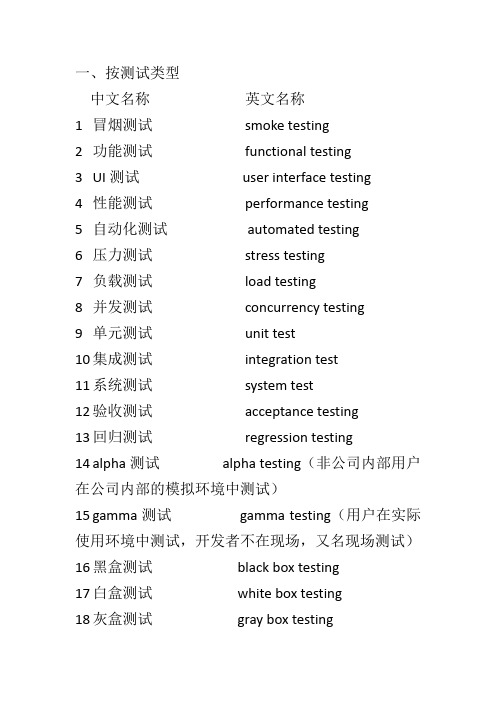
一、按测试类型中文名称英文名称1冒烟测试smoke testing2功能测试functional testing3UI测试user interface testing4性能测试performance testing5自动化测试automated testing6压力测试stress testing7负载测试load testing8并发测试concurrency testing9单元测试unit test10集成测试integration test11系统测试system test12验收测试acceptance testing13回归测试regression testing14alpha测试alpha testing(非公司内部用户在公司内部的模拟环境中测试)15gamma测试gamma testing(用户在实际使用环境中测试,开发者不在现场,又名现场测试)16黑盒测试black box testing17白盒测试white box testing18灰盒测试gray box testing19随机测试ad-hoc test20兼容性测试compatibility testing 21本地化测试localizational testing 22国际化测试international testing 23可移植性测试portability testing24引导测试pilot testing25安装测试installation testing26文档测试documentation testing 27配置测试configuration test28可靠性测试reliability test29容量测试volume test30安全性测试security test31探索性测试exploratory test32增量测试incremental test33接口测试interface testing34互操作性测试interoperability testing 35维护测试maintenance testing 36健壮性测试robustness testing37静态测试static testing38敏捷测试agile testing39自底向上测试bottom -up testing40穷尽测试exhaustive testing41确认测试confirmation testing42一致性测试conformance testing二、按测试过程1需求规格说明software-requirement specification 2测试规格说明test specification3阶段测试计划phase test plan4测试计划test plan5测试套件test suit6语句覆盖statement coverage7判定覆盖decision coverage8测试案例test case9需求矩阵requirement tracking matrix10入口准则entry criteria11出口准则exit criteria12预期结果expected outcome13实际结果actual outcome14正式评审formal review15非正式评审informal review16事件日志incident logging17输入input18输出output19结果outcome20基线baseline21模块module22运行环境operational environment 23优先级priority24交付物deliverable25评审人reviewer26测试周期test circle27测试数据test data28测试环境test environment29测试执行test execution30测试项test item31测试监控test monitoring32测试对象test object33测试报告test report34测试脚本test script35测试策略test strategy36客户端client37服务器server38浏览器browser三、按bug相关1缺陷bug2缺陷报告bug report3错误error4代码code5条件condition6缺陷跟踪defeat tracking7通过pass8失败failed9内存泄漏memory leak10路径path11风险risk12崩溃crush13调试debug14部署deployment15异常exception按工具类1回放replay2因果图cause - effect graph3编译器compiler4配置管理工具configuration management tool 5每日构建daily build6错误推测erro guessing7结构化查询语句structured query language 其它1能力成熟度模型capability maturity model 2质量控制quality control3质量保证quality assurance。
artifacts专业术语

artifacts专业术语Artifacts是指在软件开发过程中产生的各种文档、代码、测试数据和工具等,这些内容在软件开发过程中起着重要的作用,可以帮助开发者更好地理解和管理软件开发过程。
本文将介绍一些常见的Artifacts专业术语,以帮助读者更好地理解和应用它们。
1.需求文档(Requirements Document)需求文档是指描述软件系统所需功能和性能的文档。
它通常由客户或用户提供,并由开发团队进行分析和验证。
需求文档应该具体、明确、可测量和可验证,以确保软件系统满足用户需求。
2.设计文档(Design Document)设计文档是指描述软件系统设计的文档。
它通常由开发团队编写,并包括系统架构、模块设计、接口设计等内容。
设计文档应该清晰、准确、易于理解和实现,以确保软件系统满足设计要求。
3.代码(Code)代码是指实现软件系统功能的程序代码。
它通常由开发者编写,并包括各种编程语言和框架。
代码应该遵循规范、易于维护和扩展,以确保软件系统的质量和可靠性。
4.测试用例(Test Case)测试用例是指用于测试软件系统功能和性能的测试脚本。
它通常由测试团队编写,并包括各种测试场景和测试数据。
测试用例应该全面、准确、可重复和可验证,以确保软件系统满足测试要求。
5.缺陷报告(Defect Report)缺陷报告是指记录软件系统缺陷的文档。
它通常由测试团队编写,并包括缺陷描述、复现步骤、截图等内容。
缺陷报告应该准确、清晰、易于理解和修复,以确保软件系统的质量和可靠性。
6.版本控制(Version Control)版本控制是指管理软件系统代码和文档的工具。
它通常包括Git、SVN等常用的版本控制工具。
版本控制可以帮助开发团队更好地协作、管理和跟踪软件开发过程。
7.持续集成(Continuous Integration)持续集成是指将软件系统代码和文档集成到一个共享的代码库中,并自动构建、测试和部署的过程。
集成测试的方法
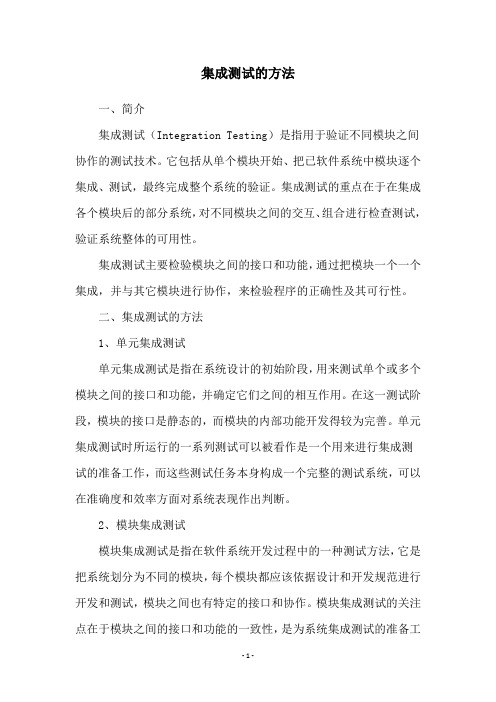
集成测试的方法一、简介集成测试(Integration Testing)是指用于验证不同模块之间协作的测试技术。
它包括从单个模块开始、把已软件系统中模块逐个集成、测试,最终完成整个系统的验证。
集成测试的重点在于在集成各个模块后的部分系统,对不同模块之间的交互、组合进行检查测试,验证系统整体的可用性。
集成测试主要检验模块之间的接口和功能,通过把模块一个一个集成,并与其它模块进行协作,来检验程序的正确性及其可行性。
二、集成测试的方法1、单元集成测试单元集成测试是指在系统设计的初始阶段,用来测试单个或多个模块之间的接口和功能,并确定它们之间的相互作用。
在这一测试阶段,模块的接口是静态的,而模块的内部功能开发得较为完善。
单元集成测试时所运行的一系列测试可以被看作是一个用来进行集成测试的准备工作,而这些测试任务本身构成一个完整的测试系统,可以在准确度和效率方面对系统表现作出判断。
2、模块集成测试模块集成测试是指在软件系统开发过程中的一种测试方法,它是把系统划分为不同的模块,每个模块都应该依据设计和开发规范进行开发和测试,模块之间也有特定的接口和协作。
模块集成测试的关注点在于模块之间的接口和功能的一致性,是为系统集成测试的准备工作。
3、系统集成测试系统集成测试是指在软件系统开发过程中的最后一种测试方法,它的目的是检查已开发的部件,验证系统的整体功能,确保系统能够按要求运行。
系统集成支持与设计开发活动有关的各种工作,以及在集成过程中引起可能的各种BUG(如参数的不匹配、操作的不一致等)。
测试过程中,发现错误后需要修改错误,这是集成测试的重要一部分内容。
四、优缺点优点:1、集成测试可以检查系统的整体功能,确保系统的稳定性和可靠性。
2、集成测试可以发现可能的Bug,避免严重的系统漏洞。
3、集成测试可以检查各个模块之间的接口和协作,确保系统能够按要求正确运行。
缺点:1、集成测试需要对系统的架构有深入的了解,以及相应的测试环境,这样才能保证测试效果。
Java初级开发工程师持续集成和持续交付方面的面试题含解答共20道题
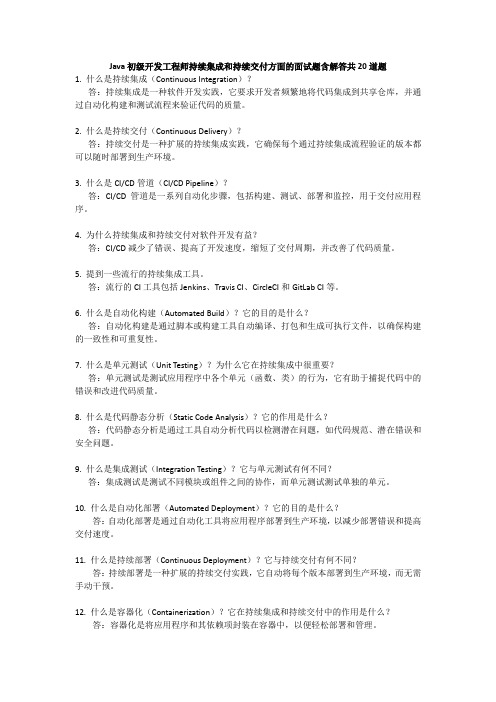
Java初级开发工程师持续集成和持续交付方面的面试题含解答共20道题1. 什么是持续集成(Continuous Integration)?答:持续集成是一种软件开发实践,它要求开发者频繁地将代码集成到共享仓库,并通过自动化构建和测试流程来验证代码的质量。
2. 什么是持续交付(Continuous Delivery)?答:持续交付是一种扩展的持续集成实践,它确保每个通过持续集成流程验证的版本都可以随时部署到生产环境。
3. 什么是CI/CD管道(CI/CD Pipeline)?答:CI/CD管道是一系列自动化步骤,包括构建、测试、部署和监控,用于交付应用程序。
4. 为什么持续集成和持续交付对软件开发有益?答:CI/CD减少了错误、提高了开发速度,缩短了交付周期,并改善了代码质量。
5. 提到一些流行的持续集成工具。
答:流行的CI工具包括Jenkins、Travis CI、CircleCI和GitLab CI等。
6. 什么是自动化构建(Automated Build)?它的目的是什么?答:自动化构建是通过脚本或构建工具自动编译、打包和生成可执行文件,以确保构建的一致性和可重复性。
7. 什么是单元测试(Unit Testing)?为什么它在持续集成中很重要?答:单元测试是测试应用程序中各个单元(函数、类)的行为,它有助于捕捉代码中的错误和改进代码质量。
8. 什么是代码静态分析(Static Code Analysis)?它的作用是什么?答:代码静态分析是通过工具自动分析代码以检测潜在问题,如代码规范、潜在错误和安全问题。
9. 什么是集成测试(Integration Testing)?它与单元测试有何不同?答:集成测试是测试不同模块或组件之间的协作,而单元测试测试单独的单元。
10. 什么是自动化部署(Automated Deployment)?它的目的是什么?答:自动化部署是通过自动化工具将应用程序部署到生产环境,以减少部署错误和提高交付速度。
软件集成测试计划书(Softwareintegrationtestingplan)
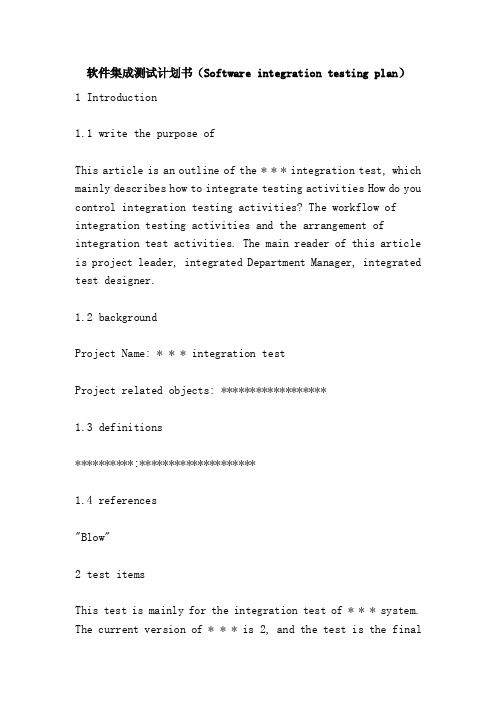
软件集成测试计划书(Software integration testing plan)1 Introduction1.1 write the purpose ofThis article is an outline of the * * * integration test, which mainly describes how to integrate testing activities How do you control integration testing activities? The workflow of integration testing activities and the arrangement of integration test activities. The main reader of this article is project leader, integrated Department Manager, integrated test designer.1.2 backgroundProject Name: * * * integration testProject related objects: ******************1.3 definitions**********:********************1.4 references"Blow"2 test itemsThis test is mainly for the integration test of * * * system. The current version of * * * is 2, and the test is the finalintegration test of * * *, which is based on the development team, programmer development, own test and development group test3 measured characteristics3.1 operational testingAre the main test operations correct and error free? It is divided into two parts:3.1.1 return testFrom the main interface step by step into the final interface, press the EXIT button to step back and check the focus of the screen when returningSuch as:1. go to system settings"2. go to channel search"3. go to automatic channel search"4. press EXIT to return to check whether the current focus is "channel search""5. press EXIT to return to check whether the current focus is system settings"3.1.2 enters the testFrom the main interface step by step into the final interface, press the MENU button to return to the main interface andre-enter to check if the focus is correctSuch as:1. go to system settings"2. go to channel search"3. go to automatic channel search"4. press the MENU button to return to the main interface5. current focus is "system settings""6. enter system settings, current focus is "channel search""3.2 function testTest the function of each application in the set top box 3.3 performance testing3.3.1 fatigue testTest continuous Boot 1 months, do not shut down the machine, every 3 days to run an application. See the stability of the system3.3.2 large capacity data testPrevious * * * database tables contain large amounts of data and test * * * functions4 non measured characteristics5 test method1. writing test plan2. review the test plan and fail to go through the first step3. write test cases;4. review the test case without passing back third steps5., testers perform test activities in accordance with test cases, and fill out test results on test reports. (test reports must cover all test cases)6. during the test, bug was found, and the bug was completed on the bugzilla and sent to the integration manager; (bug, status, NEW)7. the integration manager received the bug from bugzilla7.1 send bug to developers for obvious and immediately resolved bug (bug status, ASSIGNED);7.2 for the submission that is not bug, the integration manager informs the test designer and tester to modify the corresponding document; (bug, status RESOLVED, decision set to INVALID);7.3 for the current cannot be modified, the bug into the next round of revision; (bug RESOLVED, decided to set to REMIND)8. the developer receives the bug immediately sent, and modifies it immediately. (bug, status RESOLVED, decision set to FIXED)9., the test staff received the error information from bugzilla, and should be tested by item and fill in the new test report (the test report must cover all test cases of REOPENED in the previous test);10. if the retest has problems, return the sixth step (bug status, REOPENED)11. otherwise, turn off the BUG (bug status, CLOSED)12. in this round of tests, 95% of the test cases are tested at once, and test tasks are ended;13. of the errors found in this round of tests are modified by 98%, and by re testing (i.e., bug status, CLOSED), fifth steps are returned to perform a new round of testing;14. write test summary report after test task;15. formal tests end up in informal tests,The first is the ALPHA test, which requires other non-technical people in the company to use the system in user roles. Notice that bug informs testers that the tester processes bug events in a formal process;16. and then the BETA test, and ask the user representative for the test. Notice that bug informs testers that the tester processes bug events in a formal process.What are the instructions?:The regression test plan for three times; the test case should write more detailed steps must be clearly marked (should include: number, test description, pre conditions, test procedure and test results for the test; hope) personnel should feel test items, test personnel should report the test designer, improve and perfect the test case; separate the test report and test case, test report and test case number is marked by Y/N; the integration manager cannot determine the Shanghai project leader; fatigue test performance test can be combined in the function test, the test machine is not closed during the test; large capacity data in the performance test on the test after some rounds (second step, only one time) through 6 standard testThe test results are consistent with the mid-term results of the test case, and the test is passed, otherwise it indicates that the test has not been passed.6.1 test result approval process6.1.1 test returns end of applicationThe tester submits the application and the test is completed and submitted to the integration manager;The integration manager calls the group to meet for discussion;Discuss, pass, conduct the next test, and deploy the next round of test notes, processes, and so on;If there is any problem with the test, the next test time will be postponed and the next step should be discussed.6.1.2 test results end of applicationThe test personnel submit the application and the test is completed and submit to the integration manager;The integration manager calls the group to meet for discussion;1. discuss, pass, and test tasks;2., if there is a problem with the current test, there is no solution, the end of the test delay, and discuss how the next step should be carried out.7 test suspend and restore conditions7.1 hang up the conditionsEnter the first round of testing, testing personnel in general understand the product, if found within an hour more than 5 (including 5) operational errors, or more than 3 (including 3) functional error, return the test group test; meet integration project of higher priority tasks have integrated test; the project task higher priority; find the product to go on in the test retest of personnel, inadequate equipment. 7.2 restore conditionsWith integrated test conditions to enter (found within an hour less than 5 (excluding 5) operational errors, or less than 3 (excluding 3) functional errors); integrated test project task higher priority temporarily completed; integrated project task higher priority temporarily completed; retest in the process of product can run down; personnel, equipment in place. 8 test documents to be providedTest plan, test case, test report, test summary, 9 test taskDevelop audit test plan, develop and review test cases, test activities, write test reports, 10 test environmental requirements10.1 hardware requirements***********10.2 software requirementsThe government10.3 test tools*************10.4 test the required conditions**************10.4.1 documents requiredUser manual, application manual, installation instructions, 10.4.2, tasks that need to be completedThe programmer himself tests the test group to complete the test 11 roles and responsibilitiesIntegrated (test): manager control and complete the test tasks and the test process, decided to test the personnel submitted bug need to modify; test designer: writing integration test case; test: test activities in accordance with the test case; developers: MHP bug modified BETA test; user representatives.12 personnel and trainingThe integration test manager is responsible for testing the process of testing related personnel,Rules and regulations training; the test designer has the responsibility to test the operator, train the 13 test progressTest progress (person work day)Test plan 8Test design 60Test execution total progress 30Progress of each regression 10Test report 214 risk and contingency plansEquipment not in place: step up equipment purchase;Personnel not in placeStaff ask for leave: the person who has asked for leave to work overtime or to test progress / apply for the deployment of new staff;Personnel turnover: deployment of new personnel;Deploy personnel to other departments or projects: deploy new personnel;Developers often make mistakes: inform the development department and discuss strategies;Tests for other reasons are frequently hung up or hung up: delays or delays15 approvalIntegration Manager, technical manager Name: name:Date: date:。
软件测试词汇英文及解释

软件测试英语专业词汇1.Software life cycle———软件生命周期开始于一个软件产品的构思,结束于该产品不再被使用的这段期间。
2.Test ———测试执行软件以验证其满足指定的需求并检测错误的过程。
检测已有条件之间的不同,并评价软件项的特性软件项的分析过程。
软件工程过程的一个活动,它将软件在预定的条件下运行以判断软件是否符合预期结果。
3.Acceptance testing———验收测试,可接受性测试系统开发生命周期方法论的一个阶段,这时相关的用户和/或独立测试人员根据测试计划和结果对系统进行测试和接收。
它让系统用户决定是否接收系统。
它是一项确定产品是否能够满足合同或用户所规定需求的测试。
这是管理性和防御性控制。
4.Ad hoc testing———随机测试没有书面测试用例、记录期望结果、检查列表、脚本或指令的测试。
主要是根据测试者的经验对软件进行功能和性能抽查。
随机测试是根据测试说明书执行用例测试的重要补充手段,是保证测试覆盖完整性的有效方式和过程。
5.Alpha testing———α测试是由一个用户在开发环境下进行的测试,也可以是公司内部的用户在模拟实际操作环境下进行的受控测试,Alpha测试不能由程序员或测试员完成。
6.Automated Testing———自动化测试使用自动化测试工具来进行测试,这类测试一般不需要人干预,通常在GUI、性能等测试中用得较多。
7.Beta testing———β测试测试是软件的多个用户在一个或多个用户的实际使用环境下进行的测试。
开发者通常不在测试现场,Beta测试不能由程序员或测试员完成。
8.Black box testing———黑盒测试指测试人员不关心程序具体如何实现的一种测试方法。
根据软件的规格对软件进行各种输入和观察软件的各种输出结果来发现软件的缺陷的测试,这类测试不考虑软件内部的运作原理,因此软件对用户来说就像一个黑盒子。
9.White box testing ———白盒测试glass box testing ———玻璃盒测试根据软件内部的工作原理分析来进行测试,基于代码的测试,测试人员通过阅读程序代码或者通过使用开发工具中的单步调试来判断软件的质量,一般黑盒测试由项目经理在程序员开发中来实现。
测试方法种类有哪些

测试方法种类有哪些1. 回归测试(Regression Testing)回归测试是指修改了旧代码后,重新进行测试以确认修改没有引入新的错误或导致其他代码产生错误。
自动回归测试将大幅降低系统测试、维护升级等阶段的成本。
回归测试作为软件生命周期的一个组成部分,在整个软件测试过程中占有很大的工作量比重,软件开发的各个阶段都会进行多次回归测试。
在渐进和快速迭代开发中,新版本的连续发布使回归测试进行的更加频繁,而在极端编程方法中,更是要求每天都进行若干次回归测试。
因此,通过选择正确的回归测试策略来改进回归测试的效率和有效性是很有意义的。
2. 集成测试(Integration Testing)集成测试,也叫组装测试或联合测试。
在单元测试的基础上,将所有模块按照设计要求(如根据结构图)组装成为子系统或系统,进行集成测试。
集成测试(也叫组装测试,联合测试)是单元测试的逻辑扩展。
它最简单的形式是:把两个已经测试过的单元组合成一个组件,测试它们之间的接口。
从这一层意义上讲,组件是指多个单元的集成聚合。
在现实方案中,许多单元组合成组件,而这些组件又聚合为程序的更大部分。
方法是测试片段的组合,并最终扩展成进程,将模块与其他组的模块一起测试。
最后,将构成进程的所有模块一起测试。
此外,如果程序由多个进程组成,应该成对测试它们,而不是同时测试所有进程。
3. 功能测试(Function Testing)功能测试就是对产品的各功能进行验证,根据功能测试用例,逐项测试,检查产品是否达到用户要求的功能。
4. 内存泄漏测试(Memory Leak Testing)内存泄漏也称作“存储渗漏”,用动态存储分配函数动态开辟的空间,在使用完毕后未释放,结果导致一直占据该内存单元。
直到程序结束。
(其实说白了就是该内存空间使用完毕之后未回收)即所谓内存泄漏。
内存泄漏形象的比喻是“操作系统可提供给所有进程的存储空间正在被某个进程榨干”,最终结果是程序运行时间越长,占用存储空间越来越多,最终用尽全部存储空间,整个系统崩溃。
SIT测试报告内容包括哪些

SIT(System Integration Testing)测试报告内容包括哪些摘要本文档旨在介绍SIT(System Integration Testing)测试报告的内容要点。
SIT测试是软件开发过程中的一项重要环节,旨在验证不同系统或子系统的集成是否符合预期的功能和性能要求。
测试报告是SIT测试的重要成果之一,它记录了测试过程中的详细信息,并总结了测试结果和问题。
本文将详细介绍SIT测试报告的内容,以确保测试团队能够准确、完整地编写和呈现测试报告。
引言在SIT测试过程中,测试团队会对系统的不同模块、子系统和集成进行测试。
测试报告将记录测试执行的详细信息,包括测试计划、测试环境、测试用例和测试结果等。
通过测试报告,测试团队可以全面了解测试的进展情况,为下一步的测试活动提供参考。
测试计划测试计划是SIT测试过程的重要组成部分,它包括以下内容:1.测试目标:明确测试的目标和范围,概述测试的重点和重要性。
2.测试策略:描述测试的方法和策略,包括测试级别、测试类型、测试方法和测试技术等。
3.测试资源:指明测试所需要的资源,如测试环境、测试工具和人力资源等。
4.测试进度和里程碑:规划测试的时间安排,包括开始时间、结束时间和里程碑节点等。
5.风险评估:分析测试过程中可能出现的风险,并制定相应的应对措施。
测试环境测试环境是SIT测试过程中的一个关键因素,它提供了测试所需的硬件、软件和网络环境。
测试报告应包含以下环境信息:1.硬件环境:描述测试所用的硬件设备,如服务器、路由器、交换机等。
2.软件环境:列出测试所需的软件和工具,如操作系统、数据库、测试工具等。
3.网络环境:描述测试所用的网络配置,包括网络拓扑和网络连接等。
测试用例测试用例是SIT测试中的核心内容,它描述了测试的输入、预期输出和执行步骤。
测试报告应当包含以下测试用例信息:1.测试标识符:每个测试用例应具有唯一的标识符,以方便统计和跟踪。
2.测试描述:简要描述测试的目标和内容。
如何进行代码可靠性和鲁棒性测试
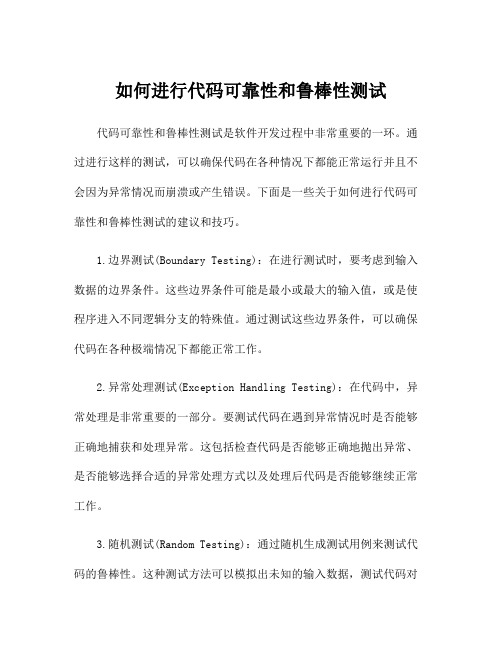
如何进行代码可靠性和鲁棒性测试代码可靠性和鲁棒性测试是软件开发过程中非常重要的一环。
通过进行这样的测试,可以确保代码在各种情况下都能正常运行并且不会因为异常情况而崩溃或产生错误。
下面是一些关于如何进行代码可靠性和鲁棒性测试的建议和技巧。
1.边界测试(Boundary Testing):在进行测试时,要考虑到输入数据的边界条件。
这些边界条件可能是最小或最大的输入值,或是使程序进入不同逻辑分支的特殊值。
通过测试这些边界条件,可以确保代码在各种极端情况下都能正常工作。
2.异常处理测试(Exception Handling Testing):在代码中,异常处理是非常重要的一部分。
要测试代码在遇到异常情况时是否能够正确地捕获和处理异常。
这包括检查代码是否能够正确地抛出异常、是否能够选择合适的异常处理方式以及处理后代码是否能够继续正常工作。
3.随机测试(Random Testing):通过随机生成测试用例来测试代码的鲁棒性。
这种测试方法可以模拟出未知的输入数据,测试代码对随机输入的反应。
通过这种方法,可以发现代码中的潜在问题并改进代码的鲁棒性。
4.边界值分析(Boundary Value Analysis):这是一种基于输入值的测试方法。
通过考虑输入值的边界情况,如最大值、最小值和边界值的前一个和后一个值,测试代码在这些情况下的行为。
这样可以发现代码中可能存在的缺陷并加以修复。
5.输入验证测试(Input Validation Testing):在进行开发时,很重要的一点是要对输入数据进行验证,以确保其符合预期的格式和内容。
通过测试不同类型和格式的输入数据,以及应对不同情况的输入数据,可以确保代码能够正确验证和处理输入数据。
6.遗传测试(Mutation Testing):这种测试方法通过对代码进行人为修改,引入不同的错误和异常情况,来检查代码是否能够正确地处理错误和异常情况。
通过对修改后的代码进行测试,可以发现和修复代码中的漏洞和缺陷。
什么是集成测试
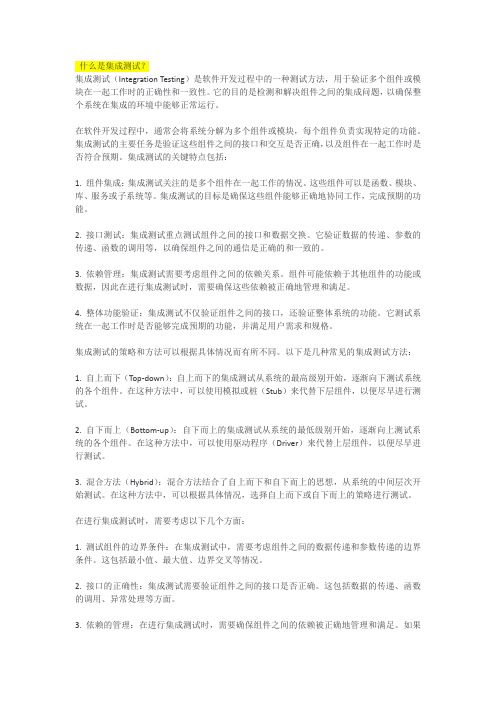
什么是集成测试?集成测试(Integration Testing)是软件开发过程中的一种测试方法,用于验证多个组件或模块在一起工作时的正确性和一致性。
它的目的是检测和解决组件之间的集成问题,以确保整个系统在集成的环境中能够正常运行。
在软件开发过程中,通常会将系统分解为多个组件或模块,每个组件负责实现特定的功能。
集成测试的主要任务是验证这些组件之间的接口和交互是否正确,以及组件在一起工作时是否符合预期。
集成测试的关键特点包括:1. 组件集成:集成测试关注的是多个组件在一起工作的情况。
这些组件可以是函数、模块、库、服务或子系统等。
集成测试的目标是确保这些组件能够正确地协同工作,完成预期的功能。
2. 接口测试:集成测试重点测试组件之间的接口和数据交换。
它验证数据的传递、参数的传递、函数的调用等,以确保组件之间的通信是正确的和一致的。
3. 依赖管理:集成测试需要考虑组件之间的依赖关系。
组件可能依赖于其他组件的功能或数据,因此在进行集成测试时,需要确保这些依赖被正确地管理和满足。
4. 整体功能验证:集成测试不仅验证组件之间的接口,还验证整体系统的功能。
它测试系统在一起工作时是否能够完成预期的功能,并满足用户需求和规格。
集成测试的策略和方法可以根据具体情况而有所不同。
以下是几种常见的集成测试方法:1. 自上而下(Top-down):自上而下的集成测试从系统的最高级别开始,逐渐向下测试系统的各个组件。
在这种方法中,可以使用模拟或桩(Stub)来代替下层组件,以便尽早进行测试。
2. 自下而上(Bottom-up):自下而上的集成测试从系统的最低级别开始,逐渐向上测试系统的各个组件。
在这种方法中,可以使用驱动程序(Driver)来代替上层组件,以便尽早进行测试。
3. 混合方法(Hybrid):混合方法结合了自上而下和自下而上的思想,从系统的中间层次开始测试。
在这种方法中,可以根据具体情况,选择自上而下或自下而上的策略进行测试。
软件测试英文面试题及答案
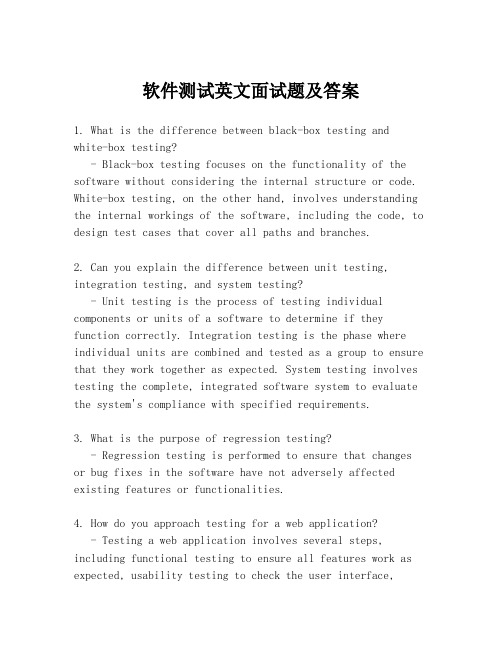
软件测试英文面试题及答案1. What is the difference between black-box testing andwhite-box testing?- Black-box testing focuses on the functionality of the software without considering the internal structure or code. White-box testing, on the other hand, involves understanding the internal workings of the software, including the code, to design test cases that cover all paths and branches.2. Can you explain the difference between unit testing, integration testing, and system testing?- Unit testing is the process of testing individual components or units of a software to determine if they function correctly. Integration testing is the phase where individual units are combined and tested as a group to ensure that they work together as expected. System testing involves testing the complete, integrated software system to evaluate the system's compliance with specified requirements.3. What is the purpose of regression testing?- Regression testing is performed to ensure that changes or bug fixes in the software have not adversely affected existing features or functionalities.4. How do you approach testing for a web application?- Testing a web application involves several steps, including functional testing to ensure all features work as expected, usability testing to check the user interface,performance testing to evaluate speed and responsiveness, security testing to identify vulnerabilities, andcompatibility testing across different browsers and devices.5. What is the role of a software tester in an Agile development environment?- In an Agile environment, a software tester is anintegral part of the development team, working closely with developers to ensure that the product meets quality standards. They are involved in the entire development cycle, from planning to delivery, and are responsible for identifying defects early and often.6. How do you prioritize test cases?- Test cases are prioritized based on several factors, including the risk associated with the feature, thecomplexity of the feature, the impact on the end-user, andthe dependencies on other features.7. Can you describe the process of test case design?- Test case design involves identifying the inputs, expected outputs, and the conditions under which a testshould be executed. It requires a thorough understanding ofthe requirements and the ability to think critically about potential scenarios and edge cases.8. What is the importance of test automation?- Test automation is crucial for improving the efficiency and effectiveness of the testing process. It allows for the rapid execution of test cases, reduces the potential for human error, and enables testers to focus on more complex andexploratory testing activities.9. How do you handle a situation where a bug is found in production?- When a bug is found in production, the first step is to verify and reproduce the issue. Once confirmed, it should be reported to the development team with detailed information. A plan should be devised to fix the bug, which may include rolling back to a previous stable version if necessary, and then conducting a thorough investigation to prevent future occurrences.10. What tools do you use for test management and automation? - There are various tools available for test management and automation, such as JIRA for test management, Seleniumfor web application testing, and Jenkins for continuous integration and test automation. The choice of tools depends on the specific needs of the project and the preferences of the testing team.。
测试英语单词

Configuration testing : 配置测试
conformance criterion: 一致性标准
Conformance Testing: 一致性测试
consistency : 一致性
consistency checker: 一致性检查器
Acceptance testing : 验收测试
Acceptance Testing:可接受性测试
Accessibility test : 软体适用性测试
actual outcome:实际结果
Ad hoc testing : 随机测试
Algorithm analysis : 算法分析
diagnostic:诊断
DIF(decimation in frequency) : 按频率抽取
dirty testing:肮脏测试
disaster recovery:灾难恢复
DIT (decimation in time): 按时间抽取
documentation testing :文档测试
Buddy test : 合伙测试
Buffer : 缓冲
Bug : 错误
Bug bash : 错误大扫除
bug fix : 错误修正
Bug report : 错误报告
Bug tracking system: 错误跟踪系统
bug:缺陷
Build : 工作版本(内部小版本)
Build Verfication tests(BVTs): 版本验证测试
Data Flቤተ መጻሕፍቲ ባይዱw Analysis : 数据流分析
软件测试英语术语缩写

软件测试常用英语词汇静态测试:Non-Execution-Based Testing或Static testing 代码走查:Walkthrough代码审查:Code Inspection技术评审:Review动态测试:Execution-Based Testing白盒测试:White-Box Testing黑盒测试:Black-Box Testing灰盒测试:Gray-Box Testing软件质量保证SQA:Software Quality Assurance软件开发生命周期:Software Development Life Cycle冒烟测试:Smoke Test回归测试:Regression Test功能测试:Function Testing性能测试:Performance Testing压力测试:Stress Testing负载测试:Volume Testing易用性测试:Usability Testing安装测试:Installation Testing界面测试:UI Testing配置测试:Configuration Testing文档测试:Documentation Testing兼容性测试:Compatibility Testing安全性测试:Security Testing恢复测试:Recovery Testing单元测试:Unit Test集成测试:Integration Test系统测试:System Test验收测试:Acceptance Test测试计划应包括:测试对象:The Test Objectives测试范围: The Test Scope测试策略: The Test Strategy测试方法: The Test Approach,测试过程: The test procedures,测试环境: The Test Environment,测试完成标准:The test Completion criteria测试用例:The Test Cases测试进度表:The Test Schedules风险:Risks接口:Interface最终用户:The End User正式的测试环境:Formal Test Environment确认需求:Verifying The Requirements有分歧的需求:Ambiguous Requirements运行和维护:Operation and Maintenance.可复用性:Reusability可靠性: Reliability/Availability电机电子工程师协会IEEE:The Institute of Electrical and Electronics Engineers) 正确性:Correctness实用性:Utility健壮性:Robustness可靠性:Reliability软件需求规格说明书:SRS (software requirement specification )概要设计:HLD (high level design )详细设计:LLD (low level design )统一开发流程:RUP (rational unified process )集成产品开发:IPD (integrated product development )能力成熟模型:CMM (capability maturity model )能力成熟模型集成:CMMI (capability maturity model integration )戴明环:PDCA (plan do check act )软件工程过程组:SEPG (software engineering process group )集成测试:IT (integration testing )系统测试:ST (system testing )关键过程域:KPA (key process area )同行评审:PR (peer review )用户验收测试:UAT (user acceptance testing )验证和确认:V&V (verification & validation )控制变更委员会:CCB (change control board )图形用户界面:GUI (graphic user interface )配置管理员:CMO (configuration management officer )平均失效间隔时间:(MTBF mean time between failures )平均修复时间:MTTR (mean time to restoration )平均失效时间:MTTF (mean time to failure )工作任务书:SOW (statement of work )α测试:alpha testingβ测试:beta testing适应性:Adaptability可用性:Availability功能规格说明书:Functional Specification软件开发中常见英文缩写和各类软件开发文档的英文缩写:英文简写文档名称MRD market requirement document (市场需求文档)PRD product requirement document (产品需求文档)SOW 工作任务说明书PHB Process Handbook (项目过程手册)EST Estimation Sheet (估计记录)PPL Project Plan (项目计划)CMP Software Management Plan( 配置管理计划)QAP Software Quality Assurance Plan (软件质量保证计划)RMP Software Risk Management Plan (软件风险管理计划)TST Test Strategy(测试策略)WBS Work Breakdown Structure (工作分解结构)BRS Business Requirement Specification(业务需求说明书)SRS Software Requirement Specification(软件需求说明书)STP System Testing plan (系统测试计划)STC System Testing Cases (系统测试用例)HLD High Level Design (概要设计说明书)ITP Integration Testing plan (集成测试计划)ITC Integration Testing Cases (集成测试用例)LLD Low Level Design (详细设计说明书)UTP Unit Testing Plan ( 单元测试计划)UTC Unit Testing Cases (单元测试用例)UTR Unit Testing Report (单元测试报告)ITR Integration Testing Report (集成测试报告)STR System Testing Report (系统测试报告)RTM Requirements Traceability Matrix (需求跟踪矩阵)CSA Configuration Status Accounting (配置状态发布)CRF Change Request Form (变更申请表)WSR Weekly Status Report (项目周报)QSR Quality Weekly Status Report (质量工作周报)QAR Quality Audit Report(质量检查报告)QCL Quality Check List(质量检查表)PAR Phase Assessment Report (阶段评估报告)CLR Closure Report (项目总结报告)RFF Review Finding Form (评审发现表)MOM Minutes of Meeting (会议纪要)MTX Metrics Sheet (度量表)CCF ConsistanceCheckForm(一致性检查表)BAF Baseline Audit Form(基线审计表)PTF Program Trace Form(问题跟踪表)领测国际科技(北京)有限公司领测软件测试网软件测试中英文对照术语表A• Abstract test case (High level test case) :概要测试用例• Acceptance:验收• Acceptance criteria:验收标准• Acceptance testing:验收测试• Accessibility testing:易用性测试• Accuracy:精确性• Actual outcome (actual result) :实际输出/实际结果• Ad hoc review (informal review) :非正式评审• Ad hoc testing:随机测试• Adaptability:自适应性• Agile testing:敏捷测试• Algorithm test (branch testing) :分支测试• Alpha testing:alpha 测试• Analyzability:易分析性• Analyzer:分析员• Anomaly:异常• Arc testing:分支测试• Attractiveness:吸引力• Audit:审计• Audit trail:审计跟踪• Automated testware:自动测试组件• Availability:可用性B• Back-to-back testing:对比测试• Baseline:基线• Basic block:基本块• Basis test set:基本测试集• Bebugging:错误撒播• Behavior:行为• Benchmark test:基准测试• Bespoke software:定制的软件• Best practice:最佳实践• Beta testing:Beta 测试领测国际科技(北京)有限公司领测软件测试网 Big-bang testing:集成测试• Black-box technique:黑盒技术• Black-box testing:黑盒测试• Black-box test design technique:黑盒测试设计技术• Blocked test case:被阻塞的测试用例• Bottom-up testing:自底向上测试• Boundary value:边界值• Boundary value analysis:边界值分析• Boundary value coverage:边界值覆盖率• Boundary value testing:边界值测试• Branch:分支• Branch condition:分支条件• Branch condition combination coverage:分支条件组合覆盖率• Branch condition combination testing:分支条件组合测试• Branch condition coverage:分支条件覆盖率• Branch coverage:分支覆盖率• Branch testing:分支测试• Bug:缺陷• Business process-based testing:基于商业流程的测试C• Capability Maturity Model (CMM) :能力成熟度模型• Capability Maturity Model Integration (CMMI) :集成能力成熟度模型• Capture/playback tool:捕获/回放工具• Capture/replay tool:捕获/重放工具• CASE (Computer Aided Software Engineering) :电脑辅助软件工程• CAST (Computer Aided Software Testing) :电脑辅助软件测试• Cause-effect graph:因果图• Cause-effect graphing:因果图技术• Cause-effect analysis:因果分析• Cause-effect decision table:因果判定表• Certification:认证• Changeability:可变性• Change control:变更控制• Change control board:变更控制委员会• Checker:检查人员• Chow's coverage metrics (N-switch coverage) :N 切换覆盖率• Classification tree method:分类树方法• Code analyzer:代码分析器• Code coverage:代码覆盖率领测国际科技(北京)有限公司领测软件测试网 Code-based testing:基于代码的测试• Co-existence:共存性• Commercial off-the-shelf software:商用离岸软件• Comparator:比较器• Compatibility testing:兼容性测试• Compiler:编译器• Complete testing:完全测试/穷尽测试• Completion criteria:完成标准• Complexity:复杂性• Compliance:一致性• Compliance testing:一致性测试• Component:组件• Component integration testing:组件集成测试• Component specification:组件规格说明• Component testing:组件测试• Compound condition:组合条件• Concrete test case (low level test case) :详细测试用例• Concurrency testing:并发测试• Condition:条件表达式• Condition combination coverage:条件组合覆盖率• Condition coverage:条件覆盖率• Condition determination coverage:条件判定覆盖率• Condition determination testing:条件判定测试• Condition testing:条件测试• Condition outcome:条件结果• Confidence test (smoke test) :信心测试(冒烟测试)• Configuration:配置• Configuration auditing:配置审核• Configuration control:配置控制• Configuration control board (CCB) :配置控制委员会• Configuration identification:配置标识• Configuration item:配置项• Configuration management:配置管理• Configuration testing:配置测试• Confirmation testing:确认测试• Conformance testing:一致性测试• Consistency:一致性• Control flow:控制流• Control flow graph:控制流图• Control flow path:控制流路径• Conversion testing:转换测试• COTS (Commercial Off-The-Shelf software) :商业离岸软件• Coverage:覆盖率• Coverage analysis:覆盖率分析领测国际科技(北京)有限公司领测软件测试网 Coverage item:覆盖项• Coverage tool:覆盖率工具• Custom software:定制软件• Cyclomatic complexity:圈复杂度• Cyclomatic number:圈数D• Daily build:每日构建• Data definition:数据定义• Data driven testing:数据驱动测试• Data flow:数据流• Data flow analysis:数据流分析• Data flow coverage:数据流覆盖率• Data flow test:数据流测试• Data integrity testing:数据完整性测试• Database integrity testing:数据库完整性测试• Dead code:无效代码• Debugger:调试器• Debugging:调试• Debugging tool:调试工具• Decision:判定• Decision condition coverage:判定条件覆盖率• Decision condition testing:判定条件测试• Decision coverage:判定覆盖率• Decision table:判定表• Decision table testing:判定表测试• Decision testing:判定测试技术• Decision outcome:判定结果• Defect:缺陷• Defect density:缺陷密度• Defect Detection Percentage (DDP) :缺陷发现率• Defect management:缺陷管理• Defect management tool:缺陷管理工具• Defect masking:缺陷屏蔽• Defect report:缺陷报告• Defect tracking tool:缺陷跟踪工具• Definition-use pair:定义-使用对• Deliverable:交付物• Design-based testing:基于设计的测试• Desk checking:桌面检查领测国际科技(北京)有限公司领测软件测试网 Development testing:开发测试• Deviation:偏差• Deviation report:偏差报告• Dirty testing:负面测试• Documentation testing:文档测试• Domain:域• Driver:驱动程序• Dynamic analysis:动态分析• Dynamic analysis tool:动态分析工具• Dynamic comparison:动态比较• Dynamic testing:动态测试E• Efficiency:效率• Efficiency testing:效率测试• Elementary comparison testing:基本组合测试• Emulator:仿真器、仿真程序• Entry criteria:入口标准• Entry point:入口点• Equivalence class:等价类• Equivalence partition:等价区间• Equivalence partition coverage:等价区间覆盖率• Equivalence partitioning:等价划分技术• Error:错误• Error guessing:错误猜测技术• Error seeding:错误撒播• Error tolerance:错误容限• Evaluation:评估• Exception handling:异常处理• Executable statement:可执行的语句• Exercised:可执行的• Exhaustive testing:穷尽测试• Exit criteria:出口标准• Exit point:出口点• Expected outcome:预期结果• Expected result:预期结果• Exploratory testing:探测测试领测国际科技(北京)有限公司领测软件测试网 Fail:失败• Failure:失败• Failure mode:失败模式• Failure Mode and Effect Analysis (FMEA) :失败模式和影响分析• Failure rate:失败频率• Fault:缺陷• Fault density:缺陷密度• Fault Detection Percentage (FDP) :缺陷发现率• Fault masking:缺陷屏蔽• Fault tolerance:缺陷容限• Fault tree analysis:缺陷树分析• Feature:特征• Field testing:现场测试• Finite state machine:有限状态机• Finite state testing:有限状态测试• Formal review:正式评审• Frozen test basis:测试基线• Function Point Analysis (FPA) :功能点分析• Functional integration:功能集成• Functional requirement:功能需求• Functional test design technique:功能测试设计技术• Functional testing:功能测试• Functionality:功能性• Functionality testing:功能性测试G• glass box testing:白盒测试H• Heuristic evaluation:启发式评估• High level test case:概要测试用例• Horizontal traceability:水平跟踪领测国际科技(北京)有限公司领测软件测试网 Impact analysis:影响分析• Incremental development model:增量开发模型• Incremental testing:增量测试• Incident:事件• Incident management:事件管理• Incident management tool:事件管理工具• Incident report:事件报告• Independence:独立• Infeasible path:不可行路径• Informal review:非正式评审• Input:输入• Input domain:输入范围• Input value:输入值• Inspection:审查• Inspection leader:审查组织者• Inspector:审查人员• Installability:可安装性• Installability testing:可安装性测试• Installation guide:安装指南• Installation wizard:安装向导• Instrumentation:插装• Instrumenter:插装工具• Intake test:入口测试• Integration:集成• Integration testing:集成测试• Integration testing in the large:大范围集成测试• Integration testing in the small:小范围集成测试• Interface testing:接口测试• Interoperability:互通性• Interoperability testing:互通性测试• Invalid testing:无效性测试• Isolation testing:隔离测试• Item transmittal report:版本发布报告• Iterative development model:迭代开发模型K• Key performance indicator:关键绩效指标领测国际科技(北京)有限公司领测软件测试网 Keyword driven testing:关键字驱动测试L• Learnability:易学性• Level test plan:等级测试计划• Link testing:组件集成测试• Load testing:负载测试• Logic-coverage testing:逻辑覆盖测试• Logic-driven testing:逻辑驱动测试• Logical test case:逻辑测试用例• Low level test case:详细测试用例M• Maintenance:维护• Maintenance testing:维护测试• Maintainability:可维护性• Maintainability testing:可维护性测试• Management review:管理评审• Master test plan:综合测试计划• Maturity:成熟度• Measure:度量• Measurement:度量• Measurement scale:度量粒度• Memory leak:内存泄漏• Metric:度量• Migration testing:移植测试• Milestone:里程碑• Mistake:错误• Moderator:仲裁员• Modified condition decision coverage:改进的条件判定覆盖率• Modified condition decision testing:改进的条件判定测试• Modified multiple condition coverage:改进的多重条件判定覆盖率• Modified multiple condition testing:改进的多重条件判定测试• Module:模块• Module testing:模块测试• Monitor:监视器• Multiple condition:多重条件• Multiple condition coverage:多重条件覆盖率领测国际科技(北京)有限公司领测软件测试网 Multiple condition testing:多重条件测试• Mutation analysis:变化分析• Mutation testing:变化测试N• N-switch coverage:N 切换覆盖率• N-switch testing:N 切换测试• Negative testing:负面测试• Non-conformity:不一致• Non-functional requirement:非功能需求• Non-functional testing:非功能测试• Non-functional test design techniques:非功能测试设计技术O• Off-the-shelf software:离岸软件• Operability:可操作性• Operational environment:操作环境• Operational profile testing:运行剖面测试• Operational testing:操作测试• Oracle:标准• Outcome:输出/结果• Output:输出• Output domain:输出范围• Output value:输出值P• Pair programming:结队编程• Pair testing:结队测试• Partition testing:分割测试• Pass:通过• Pass/fail criteria:通过/失败标准• Path:路径• Path coverage:路径覆盖• Path sensitizing:路径敏感性• Path testing:路径测试领测国际科技(北京)有限公司领测软件测试网 Peer review:同行评审• Performance:性能• Performance indicator:绩效指标• Performance testing:性能测试• Performance testing tool:性能测试工具• Phase test plan:阶段测试计划• Portability:可移植性• Portability testing:移植性测试• Postcondition:结果条件• Post-execution comparison:运行后比较• Precondition:初始条件• Predicted outcome:预期结果• Pretest:预测试• Priority:优先级• Probe effect:检测成本• Problem:问题• Problem management:问题管理• Problem report:问题报告• Process:流程• Process cycle test:处理周期测试• Product risk:产品风险• Project:项目• Project risk:项目风险• Program instrumenter:编程工具• Program testing:程序测试• Project test plan:项目测试计划• Pseudo-random:伪随机Q• Quality:质量• Quality assurance:质量保证• Quality attribute:质量属性• Quality characteristic:质量特征• Quality management:质量管理领测国际科技(北京)有限公司领测软件测试网 Random testing:随机测试• Recorder:记录员• Record/playback tool:记录/回放工具• Recoverability:可复原性• Recoverability testing:可复原性测试• Recovery testing:可复原性测试• Regression testing:回归测试• Regulation testing:一致性测试• Release note:版本说明• Reliability:可靠性• Reliability testing:可靠性测试• Replaceability:可替换性• Requirement:需求• Requirements-based testing:基于需求的测试• Requirements management tool:需求管理工具• Requirements phase:需求阶段• Resource utilization:资源利用• Resource utilization testing:资源利用测试• Result:结果• Resumption criteria:继续测试标准• Re-testing:再测试• Review:评审• Reviewer:评审人员• Review tool:评审工具• Risk:风险• Risk analysis:风险分析• Risk-based testing:基于风险的测试• Risk control:风险控制• Risk identification:风险识别• Risk management:风险管理• Risk mitigation:风险消减• Robustness:健壮性• Robustness testing:健壮性测试• Root cause:根本原因S• Safety:安全领测国际科技(北京)有限公司领测软件测试网 Safety testing:安全性测试• Sanity test:健全测试• Scalability:可测量性• Scalability testing:可测量性测试• Scenario testing:情景测试• Scribe:记录员• Scripting language:脚本语言• Security:安全性• Security testing:安全性测试• Serviceability testing:可维护性测试• Severity:严重性• Simulation:仿真• Simulator:仿真程序、仿真器• Site acceptance testing:定点验收测试• Smoke test:冒烟测试• Software:软件• Software feature:软件功能• Software quality:软件质量• Software quality characteristic:软件质量特征• Software test incident:软件测试事件• Software test incident report:软件测试事件报告• Software Usability Measurement Inventory (SUMI) :软件可用性调查问卷• Source statement:源语句• Specification:规格说明• Specification-based testing:基于规格说明的测试• Specification-based test design technique:基于规格说明的测试设计技术• Specified input:特定输入• Stability:稳定性• Standard software:标准软件• Standards testing:标准测试• State diagram:状态图• State table:状态表• State transition:状态迁移• State transition testing:状态迁移测试• Statement:语句• Statement coverage:语句覆盖• Statement testing:语句测试• Static analysis:静态分析• Static analysis tool:静态分析工具• Static analyzer:静态分析工具• Static code analysis:静态代码分析• Static code analyzer:静态代码分析工具• Static testing:静态测试• Statistical testing:统计测试领测国际科技(北京)有限公司领测软件测试网 Status accounting:状态统计• Storage:资源利用• Storage testing:资源利用测试• Stress testing:压力测试• Structure-based techniques:基于结构的技术• Structural coverage:结构覆盖• Structural test design technique:结构测试设计技术• Structural testing:基于结构的测试• Structured walkthrough:面向结构的走查• Stub: 桩• Subpath: 子路径• Suitability: 符合性• Suspension criteria: 暂停标准• Syntax testing: 语法测试• System:系统• System integration testing:系统集成测试• System testing:系统测试T• Technical review:技术评审• Test:测试• Test approach:测试方法• Test automation:测试自动化• Test basis:测试基础• Test bed:测试环境• Test case:测试用例• Test case design technique:测试用例设计技术• Test case specification:测试用例规格说明• Test case suite:测试用例套• Test charter:测试宪章• Test closure:测试结束• Test comparator:测试比较工具• Test comparison:测试比较• Test completion criteria:测试比较标准• Test condition:测试条件• Test control:测试控制• Test coverage:测试覆盖率• Test cycle:测试周期• Test data:测试数据• Test data preparation tool:测试数据准备工具领测国际科技(北京)有限公司领测软件测试网 Test design:测试设计• Test design specification:测试设计规格说明• Test design technique:测试设计技术• Test design tool: 测试设计工具• Test driver: 测试驱动程序• Test driven development: 测试驱动开发• Test environment: 测试环境• Test evaluation report: 测试评估报告• Test execution: 测试执行• Test execution automation: 测试执行自动化• Test execution phase: 测试执行阶段• Test execution schedule: 测试执行进度表• Test execution technique: 测试执行技术• Test execution tool: 测试执行工具• Test fail: 测试失败• Test generator: 测试生成工具• Test leader:测试负责人• Test harness:测试组件• Test incident:测试事件• Test incident report:测试事件报告• Test infrastructure:测试基础组织• Test input:测试输入• Test item:测试项• Test item transmittal report:测试项移交报告• Test level:测试等级• Test log:测试日志• Test logging:测试记录• Test manager:测试经理• Test management:测试管理• Test management tool:测试管理工具• Test Maturity Model (TMM) :测试成熟度模型• Test monitoring:测试跟踪• Test object:测试对象• Test objective:测试目的• Test oracle:测试标准• Test outcome:测试结果• Test pass:测试通过• Test performance indicator:测试绩效指标• Test phase:测试阶段• Test plan:测试计划• Test planning:测试计划• Test policy:测试方针• Test Point Analysis (TPA) :测试点分析• Test procedure:测试过程领测国际科技(北京)有限公司领测软件测试网 Test procedure specification:测试过程规格说明• Test process:测试流程• Test Process Improvement (TPI) :测试流程改进• Test record:测试记录• Test recording:测试记录• Test reproduceability:测试可重现性• Test report:测试报告• Test requirement:测试需求• Test run:测试运行• Test run log:测试运行日志• Test result:测试结果• Test scenario:测试场景• Test script:测试脚本• Test set:测试集• Test situation:测试条件• Test specification:测试规格说明• Test specification technique:测试规格说明技术• Test stage:测试阶段• Test strategy:测试策略• Test suite:测试套• Test summary report:测试总结报告• Test target:测试目标• Test tool:测试工具• Test type:测试类型• Testability:可测试性• Testability review:可测试性评审• Testable requirements:需求可测试性• Tester:测试人员• Testing:测试• Testware:测试组件• Thread testing:组件集成测试• Time behavior:性能• Top-down testing:自顶向下的测试• Traceability:可跟踪性U• Understandability:易懂性• Unit:单元• unit testing:单元测试• Unreachable code:执行不到的代码领测国际科技(北京)有限公司领测软件测试网 Usability:易用性• Usability testing:易用性测试• Use case:用户用例• Use case testing:用户用例测试• User acceptance testing:用户验收测试• User scenario testing:用户场景测试• User test:用户测试V• V -model:V 模式• Validation:确认• Variable:变量• Verification:验证• Vertical traceability:垂直可跟踪性• Version control:版本控制• Volume testing:容量测试W• Walkthrough:走查• White-box test design technique:白盒测试设计技术• White-box testing:白盒测试• Wide Band Delphi:Delphi 估计方法。
sit和uat

sit和uat
在企业级软件的测试过程中,经常会划分为三个阶段——单元测试,SIT和UAT,如果开发人员足够,通常还会在SIT之前引入代码审查机制(Code Review)来保证软件符合客户需求且流程正确。
下面简单介绍一下SIT和UAT的基本情况。
SIT(System Integration Testing)系统集成测试,也叫做集成测试,是软件测试的一个术语,在其中单独的软件模块被合并和作为一个组测试。
它在单元测试以后和在系统测试之前。
集成测试在已经被单元测试检验后进行作为它的输入模式,组织它们在更大的集合,和递送,作为它的输出,集成系统为系统测试做准备。
集成测试的目的是校验功能、性能和可靠性要求,配置在主设计项目中。
UAT(User Acceptance Testing)用户验收测试,通常是由最终软件的用户(通常这些用户不了解软件的具体逻辑,而对业务逻辑却相当熟悉)进行的测试,因此是面向最终用户的测试,结束之后通常就可以发布生产环境了。
区别与联系:
SIT是集成测试、UAT是验收测试
从时间上看,UAT要在SIT后面,UAT测试要在系统测试完成后才开始。
从测试人员看,SIT由公司的测试员来测试,而UAT一般是由用户来测试。
它们两个之间的专注点是不一样的。
UAT主要是从用
户层面这些去考虑和着手测试,而SIT主要是系统的各个模块的集成测试。
这在整个软件过程理论的基础知识中相当重要的。
理论上讲SIT是由专业的测试人员去完成,UAT是由用户去做的。
联调测试方案

联调测试方案1. 引言联调测试(Integration Testing)是软件开发过程中的一项重要环节,它旨在测试各个模块之间的交互是否正常,以保证整个软件系统的高质量和稳定性。
本文档将介绍联调测试的概念、目的和流程,并提供一个实施联调测试的详细方案。
2. 联调测试概述联调测试是软件测试的一种类型,它主要用于验证不同模块之间的接口能否正常通信和协同工作。
通过联调测试,可以发现和解决模块间的集成问题,确保软件系统的功能完备性和一致性。
3. 联调测试目的•发现和解决模块间集成问题:通过模拟真实环境中的各种操作和数据交互,检测模块间的接口是否完善、数据是否准确传递,以保证系统功能的正常运行。
•验证各种数据流和异常情况:通过输入各种可能的数据和操作,验证系统对于不同情况的处理能力和容错性。
•提高系统整体质量和稳定性:联调测试能够帮助发现系统中的潜在问题和漏洞,及时修复,提高系统的鲁棒性和可靠性。
4. 联调测试流程联调测试的流程可以分为以下几个阶段:4.1 规划阶段•定义联调测试的测试目标和范围:明确需要测试的模块、接口以及预期的测试结果。
•制定测试计划和测试用例:根据系统需求和功能设计,编写详细的测试计划和测试用例,以指导后续测试的执行和评估。
4.2 环境搭建阶段•搭建联调测试环境:包括软件、硬件和网络环境的配置,确保模块间的互联和通信正常。
如果存在第三方依赖或外部系统,需要模拟和集成相应的接口和数据。
4.3 测试执行阶段•执行测试用例:按照测试计划,组织测试团队进行测试用例的执行,记录测试过程和结果。
•记录和处理问题:在测试过程中发现问题,及时记录并汇报给开发团队进行修复。
4.4 结果评估阶段•分析测试结果:根据测试执行阶段的测试记录和问题反馈,分析问题的根本原因,并进行优先级排序和分类处理。
•生成测试报告:根据测试结果和分析,编写测试报告,汇总测试数据和问题统计,提出改进建议。
5. 联调测试注意事项•提前沟通和协调:各个模块的开发团队需要进行积极的沟通和协调,明确测试需求和接口规范,确保联调测试的顺利进行。
七种测试方法
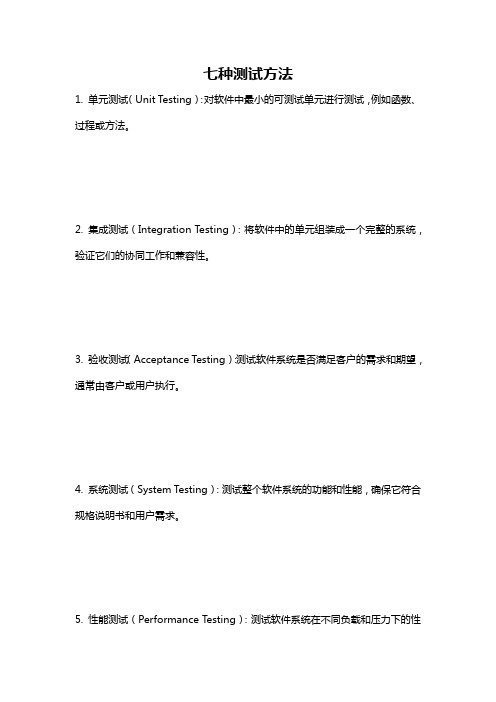
七种测试方法
1. 单元测试(Unit Testing):对软件中最小的可测试单元进行测试,例如函数、过程或方法。
2. 集成测试(Integration Testing):将软件中的单元组装成一个完整的系统,验证它们的协同工作和兼容性。
3. 验收测试(Acceptance Testing):测试软件系统是否满足客户的需求和期望,通常由客户或用户执行。
4. 系统测试(System Testing):测试整个软件系统的功能和性能,确保它符合规格说明书和用户需求。
5. 性能测试(Performance Testing):测试软件系统在不同负载和压力下的性
能、可靠性和鲁棒性。
6. 安全测试(Security Testing):测试软件系统的安全性和防御能力,包括漏洞检测、渗透测试等。
7. 回归测试(Regression Testing):在软件系统发生变化后,重新执行先前执行过的测试用例,以确保修改没有破坏原有功能。
fit原理(一)

fit原理(一)Fit原理什么是Fit原理?Fit原理,即在软件开发中的“频繁集成测试”(Frequent Integration Testing),是一种软件开发方法论。
它强调将不同部分的代码经常集成,形成一个完整的系统,并进行测试,以确保系统能够正常工作。
为什么要使用Fit原理?1.提高代码质量:通过频繁的集成测试,可以及早发现和解决各个部分之间的代码问题,降低最终系统出错的可能性。
2.加快开发速度:Fit原理鼓励团队成员不断地提交代码并进行测试,有助于尽早发现和修正错误,从而加快软件开发的速度。
3.减少集成问题:由于在整个开发过程中频繁进行集成和测试,可以最大程度地减少因集成问题而导致的系统崩溃或错误。
Fit原理的实施步骤使用Fit原理的实施步骤如下:1.明确目标:在开始开发之前,明确整个系统的目标和功能,确保所有团队成员对项目的理解一致。
2.分解系统:将整个系统分解为小的模块或功能单元,以便可分别进行开发和测试。
3.并行开发:团队成员可以同时开发不同的模块,充分利用各自的专长和经验。
4.频繁集成:每完成一个功能模块或单元的开发和测试,就立即将其与其他模块进行集成,并进行整体测试。
5.及时反馈:在整体测试过程中,及时收集并反馈各个模块的问题和错误,以便团队成员及时解决。
6.持续改进:不断总结经验教训,并在后续开发中应用,逐步提高软件开发的效率和质量。
Fit原理的优势1.提高软件质量:通过频繁集成和测试,及时发现和解决问题,避免最终系统出现重大故障。
2.加速开发时间:规避了集成问题,并且测试过程中及时反馈问题,减少需求变更的成本,加速软件开发流程。
3.增强团队合作:团队成员需要密切协作,分享经验并及时交流问题,提高团队整体效率和沟通能力。
Fit原理的适用场景Fit原理适用于以下场景:•多人协作开发情况下,项目较大或时间较紧迫;•需要频繁集成和测试的系统,如大型互联网平台、金融交易系统等;•对软件质量有较高要求,不能容忍严重错误或故障的系统。
- 1、下载文档前请自行甄别文档内容的完整性,平台不提供额外的编辑、内容补充、找答案等附加服务。
- 2、"仅部分预览"的文档,不可在线预览部分如存在完整性等问题,可反馈申请退款(可完整预览的文档不适用该条件!)。
- 3、如文档侵犯您的权益,请联系客服反馈,我们会尽快为您处理(人工客服工作时间:9:00-18:30)。
Basics
• A software module is a self-contained element of a system • Modules are individually tested commonly known as unit testing • Next major task is to put the modules, i.e., pieces together to construct the complete system • Construction of a working system from the pieces is not a straightforward task because of numerous interface errors • The objective of system integration testing (SIT) is to build a “working” version of the system – Putting modules together in an incremental manner – Ensuring that the additional modules work as expected without disturbing the functionalities of the modules already put together • Integration testing is said to be complete when – The system is fully integrated together – All the test cases have been executed – All the severe and moderated defects found have been fixed
Check-in Request Form
Incremental
• A software image is a compiled software binary • A build is an interim software image for internal testing within an organization • Constructing a build is a process by which individual modules are integrated to form am interim software image. • The final build is a candidate for system testing • Constructing a software image involves the following activities – Gathering the latest unit tested, authorized versions of modules – Compiling the source code of those modules – Checking in the compiled code to the repository – Linking the compiled modules into subassemblies – Verifying that the subassemblies are correct – Exercising version control
Different Interface Errors
• Construction • Inadequate error processing • Inadequate post-processing • Inadequate interface support • Initialization/value errors • Timing/performance problems • Coordination changes • Hardware/software interfaces
Granularity of SIT
System Integration testing is performed at different levels of granularity • Intra-system testing – This form of testing constitutes low-level integration testing with the objective of combining the modules together to build a cohesive system • Inter-system testing – It is a high-level testing phase which requires interfacing independently tested systems • Pairwise testing – In pairwise integration, only two interconnected systems in an overall system are tested at a time – The purpose of pairwise testing is to ensure that two systems under consideration can function together, assuming that the other systems within the overall environment behave as expected
Incremental
• Integration testing is conducted in an incremental manner as a series of test cycles • In each test cycle, a few more modules are integrated with an existing and tested build to generated larger builds • The complete system is built, cycle by cycle until the whole system is operational for system-level testing. • The number of SIT cycles and the total integration time are determined by the following parameters: – Number of modules in the system – Relative complexity of the module (cyclomatic complexity) – Relative complexity of the interfaces between the modules – Number of modules needed to be clustered together in each test cycle – Whether the modules to be integrated have boon adequately tested before – Turnaround time for each test-debug-fix cycle
Different Types of Interfaces
Three common paradigms for பைடு நூலகம்nterfacing modules: • Procedure call interface • Shared memory interface • Message passing interface
The problem arises when we “put modules together” because of interface errors
Interface errors Interface errors are those that are associated with structures existing outside the local environment of a module, but which the module uses
Basics
The major advantages of conducting SIT are as follows: • Defects are detected early
• It is easier to fix defects detected earlier
• We get earlier feedback on the health and acceptability of the individual modules and on the overall system • Scheduling of defect fixes is flexible, and it can overlap with development
System Integration Techniques
Common approaches to perform system integration testing • Incremental • Top-down • Bottom-up • Sandwich • Big-bang
Pre-requisite A module must be available to be integrated A module is said to available for combining with other modules when the module’s check-in request form is ready
Incremental
• A release note containing the following information accompanies a build. – What has changed since the last build? – What outstanding defects have been fixed? – What are the outstanding defects in the build? – What new modules, or features, have been added? – What existing modules, or features, have been enhanced, modified, or deleted? – Are there any areas where unknown changes may have occurred? • A test strategy is created for each new build and the following issues are addressed while planning a test strategy – What test cases need to be selected from the SIT test plan? – What previously failed test cases should now be re-executed in order to test the fixes in the new build? – How to determine the scope of a partial regression tests? – What are the estimated time, resource demand, and cost to test this build?
